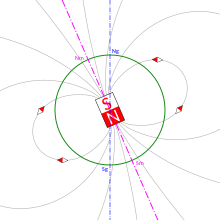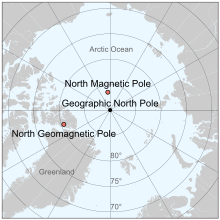
Back القطب الجيومغناطيسي الأرضي Arabic Pol geomagnètic Catalan Pol (Geomagnetismus) German Polo geomagnético Spanish قطب زمینمغناطیسی Persian Մագնիսական բևեռ Armenian გეომაგნიტური პოლუსი Georgian Geomagnetisk pol NN Biegun geomagnetyczny Polish


The geomagnetic poles are antipodal points where the axis of a best-fitting dipole intersects the surface of Earth. This theoretical dipole is equivalent to a powerful bar magnet at the center of Earth, and comes closer than any other point dipole model to describing the magnetic field observed at Earth's surface. In contrast, the magnetic poles of the actual Earth are not antipodal; that is, the line on which they lie does not pass through Earth's center.
Owing to the motion of fluid in the Earth's outer core, the actual magnetic poles are constantly moving (secular variation). However, over thousands of years, their direction averages to the Earth's rotation axis. On the order of once every half a million years, the poles reverse (i.e., north switches place with south) although the time frame of this switching can be anywhere from every 10 thousand years to every 50 million years.[2] The poles also swing in an oval of around 50 miles (80 km) in diameter daily due to solar wind deflecting the magnetic field.[3]
Although the geomagnetic pole is only theoretical and cannot be located directly, it arguably is of more practical relevance than the magnetic (dip) pole. This is because the poles describe a great deal about the Earth's magnetic field, determining for example where auroras can be observed. The dipole model of the Earth's magnetic field consists of the location of geomagnetic poles and the dipole moment, which describes the strength of the field.[3]
| Year | 1990 (definitive) | 2000 (definitive) | 2010 (definitive) | 2020 |
|---|---|---|---|---|
| North geomagnetic pole | 79°12′N 71°06′W / 79.2°N 71.1°W | 79°36′N 71°36′W / 79.6°N 71.6°W | 80°06′N 72°12′W / 80.1°N 72.2°W | 80°42′N 72°42′W / 80.7°N 72.7°W |
| South geomagnetic pole | 79°12′S 108°54′E / 79.2°S 108.9°E | 79°36′S 108°24′E / 79.6°S 108.4°E | 80°06′S 107°48′E / 80.1°S 107.8°E | 80°42′S 107°18′E / 80.7°S 107.3°E |
| Magnetic dipole moment |
7.84 | 7.79 | 7.75 | 7.71 |
- ^ "Magnetic North, Geomagnetic and Magnetic Poles". wdc.kugi.kyoto-u.ac.jp. Retrieved 2019-12-18.
- ^ "Is it true that Earth's magnetic field occasionally reverses its polarity?". www.usgs.gov. Retrieved 2021-09-16.
- ^ a b Nair, Manoj C. (10 March 2022). "Wandering of the Geomagnetic Poles | NCEI". www.ngdc.noaa.gov.
- ^ Cite error: The named reference
WDCGwas invoked but never defined (see the help page).